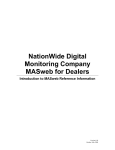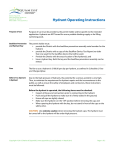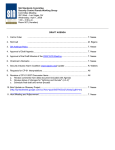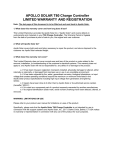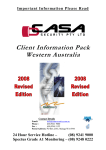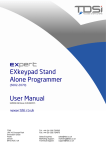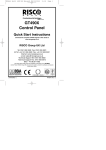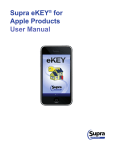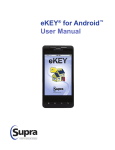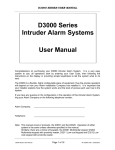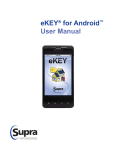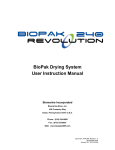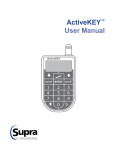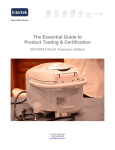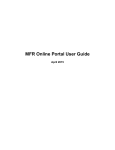Download SECURITY & MONITORING QUICK GUIDE
Transcript
SECURITY & MONITORING QUICK GUIDE Now that you have your security system installed, use it regularly. Regular usage will increase your comfort with operating the system and reduce the likelihood of false alarms. Most importantly, your home or business will be protected and secured. Please refer to our Welcome Booklet supplied to you by our technician for expanded details of the following sections. Arming Your System To monitor for intrusion, your system must be armed to stay or away mode. Other custom modes can be set depending on your needs. Your installer can go over these with you during installation. Door & Windows (Stay Mode) This arms perimeter access points (doors and windows) and is generally used when you wish to arm the security system, but remain at home. Primary entry doors are programmed with a delay* before the siren sounds. Door & Windows + Motions (Away Mode) This arms all intrusion monitoring devices including motion and glass break sensors and is used when no one is home or when you close your business for the day. Primary entry doors are programmed with a delay* before the siren sounds. *There are 2 types of delays. An entry delay gives you time to enter your home while your system is armed and enter your user access code. If the code is entered during the delay period the alarm siren will not sound. An exit delay gives you time to set your alarm and exit your home before your system becomes armed. Your system is always monitoring for smoke & fire, CO poison, flood and extreme temperature changes as long as you have the appropriate equipment installed. Arming and disarming your system does not impact the monitoring of these services. www.libertylive.ca 1-866-926-SAFE(7233) www.libertysecurity.ca Page 1 Keypad User Codes To arm and disarm your security system, a keypad user code is required. These are 4-digit codes that are entered into the keypad. Security key fobs are also available and can be used to arm and disarm your alarm system with the press of a button. Master Code A master code allows you to make program changes to your system such as changing the time and adding new user access codes. It is also used to arm and disarm your system. We recommend that only the owner of the system know and use the master code. User Access Code A user access code is a numeric code used to arm and disarm your system. It cannot be used to make program changes, unless it is the same as the master code. Verbal Code Word Verbal code words are used to help us confirm the identity of you or a key holder. Account owners have a master verbal code word, which must be given before making system or account changes. Key holders use a verbal password to confirm their identity before an operator will release alarm information to them. Verbal code words should be different from your user access code. Duress Code This special keypad access code allows you to immediately notify our monitoring center that you are in imminent danger. This code is designed to be used when someone is forcing you to disarm your security system. When this code is received, we will immediately dispatch the police on a high priority response. Duress codes are treated with the highest priority and should be used only in the event of a real emergency. Improper use may result in fines from your local authorities. IMPORTANT: If you do not have a cellular communicator such as those in the liberty live, energy, smart lock and full home automation packages, your security system communicates with our monitoring center through your phone line. To ensure this connection is not interrupted, please notify us immediately of any changes to your phone service. For additional security, ask us about adding Liberty Live service to your account. www.libertylive.ca 1-866-926-SAFE(7233) www.libertysecurity.ca Page 2 Alarm Monitoring /Enhanced Monitoring Services Monitronics can monitor its customers for intrusion, smoke, fire, flood, carbon monoxide, extreme temperature, medical and personal emergencies. Devices in the home send signals to the central control panel, which in turn sends those signals to one of the Monitoring Centres. Operators handle each emergency using strict contact and dispatch procedures. The process they follow depends on the types of signals that are received (intrusion, fire, panic, etc). The Monitoring Centres are certified by the Underwriters Laboratories Canada, and are registered with the Central Station Alarm Association (CSAA). Once a signal is received by the Monitoring Center, within seconds screens pop up and the operators can view: • What type of emergency it is (burglary, fire, flood, etc) • The customer’s relevant information • Who to contact • Which local authorities to dispatch • Everything they need to know in order to deal with the situation quickly and effectively You will be asked to provide the following information: • Your full name • Customer Number or ten-digit phone number • Verbal code word to verify you are an authorized keyholder or contact for the premises. New System Checklist The following checklist is an overview of important things you should do to maximize the benefits of your new system. Familiarize yourself and other users with your system Any person who will be using the system (family members, employees) should be familiar with the basic operations of your new system. Select and inform your key holders Key holders are family and friends who could be contacted in the event of an alarm. www.libertylive.ca 1-866-926-SAFE(7233) www.libertysecurity.ca Page 3 Contact your insurance company With a monitored security system you may receive a discount on your home or business premium. Use your lawn sign and stickers Be sure that they are visible, they are your first line of defense. Familiarize yourself with local bylaws Every local jurisdiction in Canada has their own unique bylaws and response protocols. To avoid potential false alarm fines, be sure to read and adhere to your local bylaw requirements, verify with your local Police Department or Bylaw Enforcement Service. When required, please call us with the permit# so it can be used for monitoring purposes. Use your system regularly Use your system regularly New residential accounts are placed on a 7-day test period while customers are learning to use their system. If during this time frame, an intrusion alarm is received in the Monitoring Centre, we will call all the Contacts on your account and only dispatch if instructed to do so. This is done to avoid false alarms. Other Alarm types - Fire, Panic and Medical - are not impacted by the 7-day test period and will be responded to and dispatched appropriately. Maintenance Checklist We recommend performing the following steps to ensure your system operates efficiently and effectively. Use your system daily Whether you’re home or away, get into the habit of using your system every day. Test your system monthly To ensure that your system is operating properly, test your system on a regular basis. Testing is simple and takes a few minutes to complete. www.libertylive.ca 1-866-926-SAFE(7233) www.libertysecurity.ca Page 4 Visit www.mymonitronics.com, select ‘My System’, then ‘System Test’. Follow the steps on the online tool including: 1. Confirm your code word 2. Accept the terms and conditions 3. The system will now be in a ‘test’ mode for the next two hours 4. To view the results of each device, click the ‘test Results’ tab 5. Follow the manufacturer’s testing procedures in your user manual When you have finished testing your system, remember to take the system off of test by following these steps: 1. My System, then ‘System Test’ 2. Click ‘Test’ Results 3. Click ‘End Test’ It’s important to remember that while your system is on test, we will not respond to any alarm signals, including medical and fire alarms. NEVER test a smoke detector, the medical, police, fire or key fob panic buttons without calling the monitoring station first to tell them you are testing the system. You will be liable for false alarm fines from the authorities if you fail to call ahead. Notify us and remind key holders when you’re away If you’re going on holidays or going to be away for an extended period of time, please let us and your key holders know so we can all respond effectively to any alarms or events while you’re away. Update your emergency contacts and key holders If your personal contact information, emergency contacts, or key holders change, it’s important that you contact us. We use this information in our response protocol when there is an alarm or event. Replace any expired batteries in your system All security systems use batteries, which wear down over time. Wireless devices have batteries in the individual devices (e.g. a door contact or smoke sensor) and all systems will have a back up battery in the control panel. www.libertylive.ca 1-866-926-SAFE(7233) www.libertysecurity.ca Page 5 If you have any questions about using your security system, please refer to your manual or do not hesitate to contact us at 1-866-926-7233 Arming a sensor instructs the panel to generate an alarm when a door or window is opened or when an unauthorized person enters a specific area. To ARM your system while you are staying at home (STAY MODE) ensure that all doors and windows are closed. Press DOOR & WINDOWS ONLY. Press silent arming ON to silence the countdown beeping. To ARM your system when all occupants are leaving the home (AWAY MODE) ensure that all doors and windows are closed. Press ARM ALL. If you select an arming option, and there is an arming problem, an arming error message screen will appear indicating what the problem is and how to correct it. Correct the problem (such as closing the patio door) as indicated or press the Bypass button. You will see the arming countdown message at the bottom of the screen. You can touch the Cancel button and enter your code to stop the arming process. DISARMING requires a valid user code makes the intrusion sensors inactive in the system. Bypassing Sensors Bypassing a sensor allows you to open the sensor while the system is armed. This can allow you to arm the system while leaving one zone bypassed, for example a kitchen window. Bypassed sensors do not stay bypassed when the arming level is changed. You will have to bypass a sensor each time you arm the system. To bypass a sensor: 1. Press the (COG) symbol 2. Select “Direct Bypass” 3. Enter your master code 4. Next to the sensor name, select “Bypassed” www.libertylive.ca 1-866-926-SAFE(7233) www.libertysecurity.ca Page 6 Trouble Beeps Your system is able to automatically test for: • Power failures • Low batteries • Nonworking sensors • Communication trouble with the central monitoring station When your system detects one of the above problems, six rapid beeps sound every minute until the trouble condition is corrected. To stop the trouble beeps, press and then press the (COG) icon or arm then disarm the system while the trouble condition exists. Trouble beeps will resume 4 hours later unless the trouble condition is corrected. Adding/Changing user codes There are three types of access codes. The Master code is your most powerful code and be used for all user operations including programming. There also is up to eight User codes, which can be used for basic user operations. Initially, all user codes are blank. A user code can be deleted by pressing Delete while the code is being changed. To add/edit access codes: 1. From the programming screen, press “Access Codes” 2. To add or edit an access code, press the white field next to the access code. 3. Enter the new four digit code on the keypad and press “Save” 4. Press “Close” repeatedly to exit menus. If you have subscribed to one of our Liberty Live Interactive packages, most of these functions can be completed on your smartphone app or online as well as control and notifications of thermostats, door locks and appliance modules. www.libertylive.ca 1-866-926-SAFE(7233) www.libertysecurity.ca Page 7







